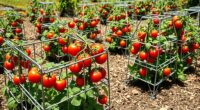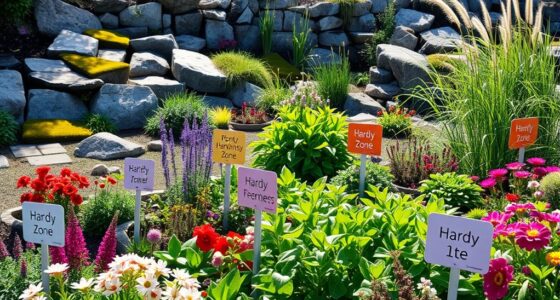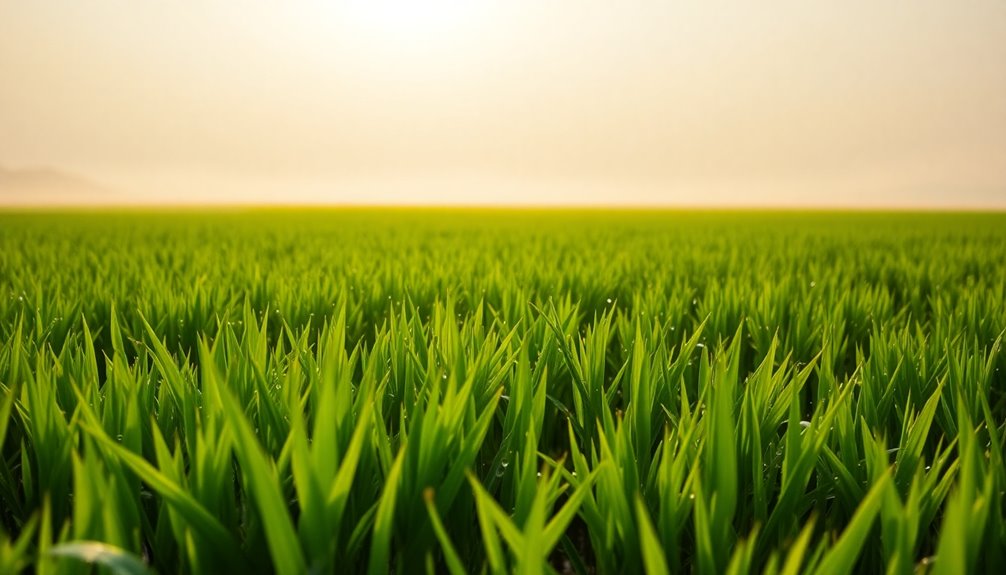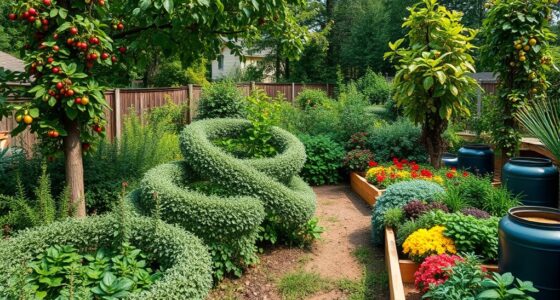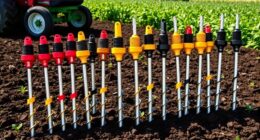To keep your garden thriving, water deeply and consistently to prevent both overwatering and underwatering. Use drip systems or soaker hoses connected to rain barrels for targeted, efficient watering that minimizes waste and evaporation. Collect rainwater to save costs and support eco-friendly practices. By combining proper moisture levels with sustainable tools like rain barrels and drip irrigation, you’ll promote healthy growth and conserve resources—discover even more ways to optimize your garden’s hydration soon.
Key Takeaways
- Use drip irrigation systems to deliver consistent, targeted water directly to plant roots, reducing waste and promoting healthy growth.
- Collect rainwater with barrels to create an eco-friendly, cost-effective water source for your garden.
- Maintain proper soil moisture levels by monitoring and adjusting watering schedules based on plant needs and weather conditions.
- Water deeply and infrequently to encourage strong root development and drought resistance.
- Combine rain barrels with drip systems for efficient, sustainable, and precise garden watering.
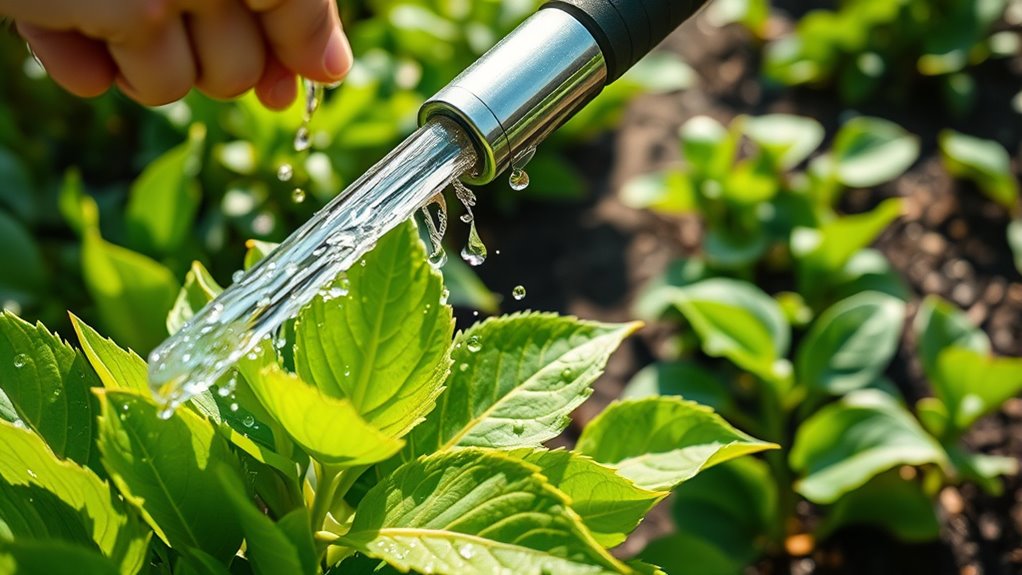
A well-watered garden is the foundation of healthy, thriving plants, but providing the right amount of moisture can be tricky. Overwatering leads to root rot and fungal diseases, while underwatering causes stress and stunted growth. To maintain ideal moisture levels, consider implementing efficient irrigation methods like drip systems and rain barrels. Drip systems are an excellent way to deliver water directly to your plants’ roots, minimizing waste and evaporation. They work by slowly releasing water through a network of hoses and emitters, ensuring your plants receive consistent moisture without oversaturating the soil. You can customize these systems to suit different plant types and garden zones, saving you time and effort while promoting healthy growth. Incorporating good lighting and proper soil preparation further enhances your garden’s vitality, creating optimal conditions for your plants to thrive.
Rain barrels are another eco-friendly and cost-effective tool for garden watering. Positioned under downspouts, they collect rainwater from your roof, providing a free source of clean, natural irrigation. Using rain barrels reduces your reliance on municipal water supplies, which is especially beneficial during dry seasons or droughts. They’re simple to set up and maintain, and you can connect them to your drip system or watering cans for easy distribution. By harvesting rainwater, you also help prevent runoff and soil erosion, which can carry away nutrients and harm local waterways.
Incorporating rain barrels into your watering routine allows you to use water more efficiently and sustainably. During rainy days, you can fill your rain barrel and then use that stored water during dry spells, ensuring your garden stays moist without overextending your water supply. When combined with drip systems, rain barrels offer a precise, controlled way to keep your garden hydrated. You can attach a soaker hose or drip emitters directly to the barrel’s spigot, giving you a steady flow of water that penetrates deeply into the soil where your plants need it most. This setup reduces water waste by avoiding runoff and evaporation, which are common with traditional sprinklers.
Frequently Asked Questions
How Can I Tell if My Garden Needs More or Less Water?
To determine if your garden needs more or less water, check the soil moisture by feeling it about 1-2 inches deep; it should feel damp but not soggy. Watch for plant wilt, which indicates dehydration, or overly lush, soft leaves that may suggest overwatering. Adjust your watering routine accordingly, ensuring plants get enough moisture without drowning their roots. Proper soil moisture keeps your garden healthy and thriving.
What Are the Best Times of Day to Water My Plants?
Remember, choosing the right watering schedule is key. The best times of day to water your plants are early morning or late afternoon, like a well-planned campaign from a vintage playbook. Watering during these times minimizes evaporation and guarantees proper plant hydration. Avoid midday watering, which can scorch leaves and waste water. Consistent, well-timed watering helps your garden stay healthy and vibrant, giving your plants the hydration they need to thrive.
How Do I Prevent Overwatering and Root Rot?
To prevent overwatering and root rot, you need to monitor your soil moisture carefully. Use mulch benefits to retain soil moisture while improving soil drainage, which helps prevent excess water from sitting around roots. Water only when the top inch of soil feels dry, and make certain your garden has proper drainage. This approach keeps roots healthy, avoids overwatering, and promotes a thriving garden.
Are There Eco-Friendly Irrigation Options Available?
You might wonder if eco-friendly irrigation options exist. Research shows that drip irrigation conserves water by delivering it directly to plant roots, reducing waste. Rain barrels collect rainwater, lowering reliance on tap water and decreasing environmental impact. These methods are sustainable, cost-effective, and gentle on your garden. Switching to drip systems or rain barrels helps protect the environment while keeping your garden healthy and thriving.
How Often Should I Adjust Watering Schedules for Seasonal Changes?
You should adjust your watering schedule regularly to match seasonal rainfall and the plant growth stages. As seasons change, rainfall may increase or decrease, so watering less during rainy periods and more during dry spells helps prevent over- or under-watering. Monitor your plants closely; young or new growth needs more consistent moisture, while mature plants might require less. Staying flexible guarantees your garden stays healthy year-round.
Conclusion
By following these watering and irrigation tips, you’re nurturing your garden like a diligent gardener tending to the roots of a mighty oak. Remember, consistent care and thoughtful watering turn a simple patch of soil into a lush paradise—your personal Eden. With patience and attention, you’ll watch your plants flourish, much like the legendary gardens of old. Keep these tips close, and your garden will thrive as if touched by nature’s own magic.


